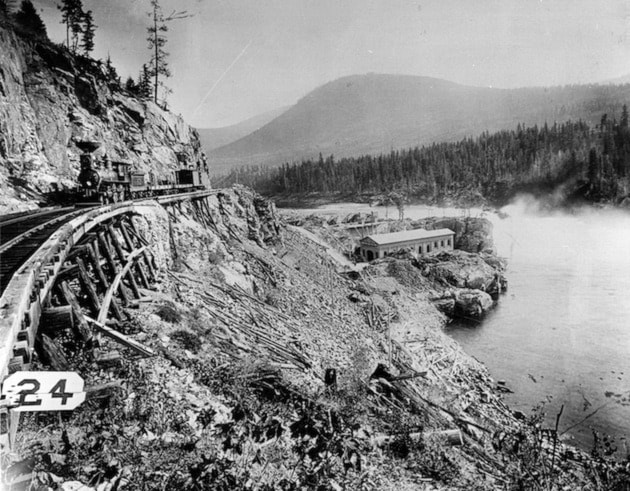A letter of mine about Savary Island in BC History magazine brought an interesting new connection. Edwin Conde Landale, a member of the Savary Island Heritage Society, purchased my book on Edward Mahon, and started sending me new insights into lives of people mentioned in it, many in some way connected to the island. My letter dealt with the 1935 Vancouver School of Art sketching camp on the island, which provided an annual retreat for artists, held at the Royal Savary Hotel.
The most interesting of these is the story of Hugh F. Keefer. A part of the story comes from his son, Harry, a long-time Savary Island resident who distinguished himself as an official of all trades, from port warden to postmaster. In a 1941 interview he reminisces how he was a childhood friend of “Eddie” Beatty — long-serving president of the CPR when the interview was published — and he reflects on their divergent paths:
“I often think of poor Eddie today, his independence gone, slaving out his life at the beck and call of a huge corporation when he might just as well have become a free and independent storekeeper on Savary Island!”
Harry and his father Hugh Forbes Keefer left their Thorold, Ont. home in 1882, picking up Joe McFarland on their way in Detroit. J.W. McFarland was a Keefer relative, and destined to become Edward Mahon’s right-hand man and business partner. His mother, Amelia Keefer, was a sister of Hugh’s father John. After settling in Vancouver, Hugh secured a subcontract to build a number of tunnels for CPR contractor Andrew Onderdonk.
When that work was completed Hugh joined several other railway contractors to acquire real estate holdings in what would become the centre of Vancouver. He obtained a mortgage in 1889 from John Mahon, when Edward’s brother was on his exploratory cruise and had settled on the Vancouver area for investment. The consortium similarly felt that they had invested wisely: sooner or later the CPR would see the folly of choosing Port Moody as their Pacific railway terminus.
Flush with success and great expectations, Hugh then ventured to the West Kootenay, taking out the contract for the construction of the eastern 14 miles of the Columbia and Kootenay Railway in 1890. That was to be his undoing.
Articles in the Nelson Miner document how the railway called the shots and undermined the efforts of the grade contractors. The low bids forced lower wages and labour had to be imported from the east — all to the profit of the company that charged two-way fares whether the prospective employee took advantage of it or not. When the men arrived, they found wages to be lower than promised by the CPR agents, and many quit. The contractors, of course, bore the brunt of employee dissatisfaction.
Potential efficiencies were lost when the CPR laid down the track on its own schedule. Other problems intervened for Keefer: supplies had to be brought in on the longer route via Bonner’s Ferry, a barge of powder was lost in the Columbia, heavy rains ravaged completed work and caused landslides, and blasting accidents claimed lives. Hugh Keefer had the worst of the bargain: most of his terrain was rock and required rock cuts or trestles.
By the time work was completed in the spring of 1891, Hugh was $45,000 in debt. To meet his obligations he obtained a loan from the Bank of BC, with his land holdings as collateral. Railway work, however, was no longer paying as well as it once had, and he could not come up with the balance of the loan when it was called. So he lost his chance at becoming a wealthy Vancouver developer, although the family name is preserved by Keefer St.
Joseph McFarland remained in dedicated service to Edward’s company and was an honorary pall bearer at his funeral on June 22, 1937. He would outlive him by one month. Joseph’s brother George and his nephew Frank owned one of the first houses on Savary after the 1910 subdivision.
Edward Mahon had been a long-time supporter of T.S.H. Shearman, whose astronomical ventures promised to put Vancouver at the forefront of discovery. Unfortunately, the meteorologist’s vision exceeded his practical ability, and the plans collapsed. His brother, R.S. Sherman (he used a different spelling), was also a central figure in the early subdivision of Savary Island.
Edwin refers to these ramifications as “trivial tangents,” but I find the connections to an island I knew little about to be absolutely amazing.
I am indebted to E.C. Landale for providing these tantalizing tangents.
Walter Volovsek’s website can be found at trailsintime.org
Previous installments in this series
Reappraising the Franklin Expedition
Connecting with Albert McCleary
Lilette Mahon: A mentor’s gift
Edward Mahon: Searching for a legacy
Edward Mahon: A stimulating childhood
Intrigues: Castlegar’s lacklustre childhood
Perceptions: Adrift on the River of Life
Local history interwoven with rivers
Drawn into the currents of time
